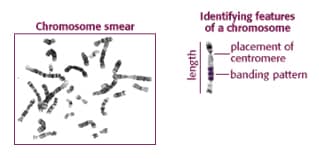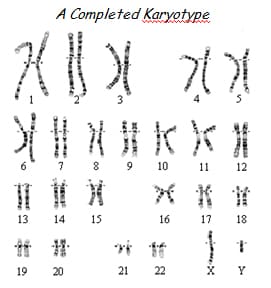A karyotype is an organized profile of a person’s chromosomes.
Chromosomes are arranged and numbered according to:
– size, from largest to smallest
– banding pattern, size and location of Giesma bands
– centromere location, appear as a constriction

This arrangement helps scientists quickly identify chromosomal alterations that may result in a genetic disorder.
Karyotype analyses are performed over 400,000 times per year in the U.S. and Canada.
How a karyotype is made:
1. Cells are blocked during mitosis.
2. The chromosomes are taken from those cells, attached to a slide, and are stained with Giemsa dye (pronounced Jeem-suh). The dye stains regions of chromosomes that are rich in the base pairs Adenine (A) and Thymine (T) producing a dark band.
3. Pictures of the chromosomes are taken, cut out and matched up according to size, banding pattern and centromere position as guides.

Interpreting a karyotype:
Scientists use a specific notation to characterize the karyotype.
This notation includes:
i) the total number of chromosomes
ii) the sex chromosomes
iii) any extra or missing autosomal chromosomes
For example,
47, XY, +18 indicates that the patient has 47 chromosomes, is a male, and has an extra autosomal chromosome 18.
46, XX is a female with a normal number of chromosomes
47, XXY is a patient with an extra sex chromosome.
Making a diagnosis with a karyotype:
Scientists can diagnose or predict genetic disorders by looking at the chromosomes in a karyotype.
Karyotype analysis is used in prenatal testing and in diagnosing certain disorders, such as Down syndrome.
Some chromosome aberrations in humans:
| Chromosome abnormality | Syndrome name (condition) | Effects on individual (variable) |
| X | Turner’s | ●sterile female
●underdeveloped female characteristics ●short stature ●sometimes below normal intelligence |
| XXY | Klinefelter’s | ●sterile male
●abnormal male characteristics ●abnormally long arms and legs ●below normal intelligence |
| Trisomy #21 | Down’s | ●low mental ability
●short arms and legs ●internal defects ●distinct facial features |
| Trisomy #18 | Edwards | ●severe abnormalities
●life expectancy about 10 weeks |
| Trisomy #13 | Patans | ●severe defects including small, non-functioning eyes
●survive only a few weeks after birth |
| Defective #5 (part of chromosome missing) | Cri du chat | ●severe defects, both physical and mental
●sound, when crying, similar to a cat’s meow |
